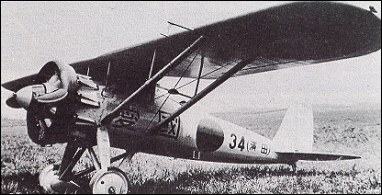|
| A Japanese army requirement of 1927 for a new single-seat fighter was contested by Nakajima, Kawasaki and Mitsubishi. All the designs were parasol-wing monoplanes developed in Japan by teams wholly or partly led by Europeans, in the case of Nakajima the French engineers Mary and Robin, Structural failure of the Mitsubishi prototype led to severe testing of the survivors, which were then also eliminated. The Nakajima: prototype, company designation NC, had a slim tapering monocoque fuselage, an uncowled Jupiter radial engine, and elaborate strut bracing connecting wings, fuselage and the wide-track landing gear. Nakajima persevered with the design and built six more prototypes, the last of the series being tested extensively by the Japanese army and accepted for production as the Army Type 91 Fighter Model 1. Retaining the same basic configuration as the NC prototype, this was virtually a redesign which resulted in a considerably refined airframe. Production of the Type 91 terminated in 1934 with the 450th aircraft; of these 22 were Army Type 91 Fighter Model 2 aircraft with modified engine cowlings. A Type 91 was converted for carrier operations and with spatted wheel fairings was submitted for the navy 7-Shi experimental fighter competition, but was rejected. The only other modification from standard army configuration was the use of a three-bladed propeller.
Introduced from 1932 onwards, the Type 91s were deployed in action with the four squadrons of the 11th Air Battalion operating with the army Kanto Command in Manchuria against the Chinese. In. 1933 the Type 91 was the principal army fighter and constituted the standard equipment for the newly formed air wings (or Hiko Rentai).
| MODEL | Type 91 |
| CREW | 1 |
| ENGINE | 1 x Nakajima "Kotobuki-2", 433kW |
| WEIGHTS |
| Take-off weight | 1500 kg | 3307 lb |
| Empty weight | 1075 kg | 2370 lb |
| DIMENSIONS |
| Wingspan | 11 m | 36 ft 1 in |
| Length | 7.3 m | 24 ft 11 in |
| Height | 3 m | 10 ft 10 in |
| Wing area | 20 m2 | 215.28 sq ft |
| PERFORMANCE |
| Max. speed | 300 km/h | 186 mph |
| Ceiling | 9000 m | 29550 ft |
| Range | 500 km | 311 miles |
| ARMAMENT | 2 x 7.7mm machine-guns |
| e, e-mail, 21.02.2025 14:55 e reply |
| Angela, 18.06.2011 10:49 The only other modification from standard army configuration was the use of a three-bladed propeller. reply |
|
Do you have any comments?
|
| 
COMPANY
PROFILE
All the World's Rotorcraft
|







 Angela
Angela
20
reply